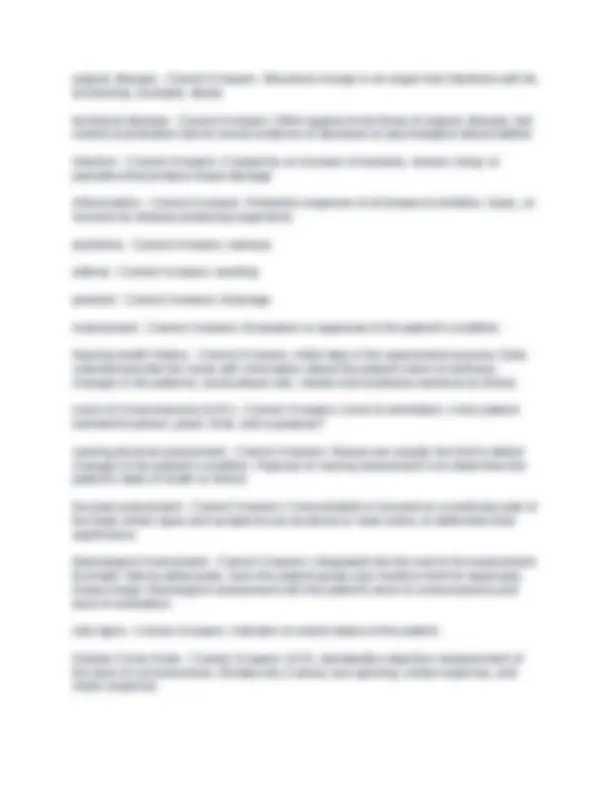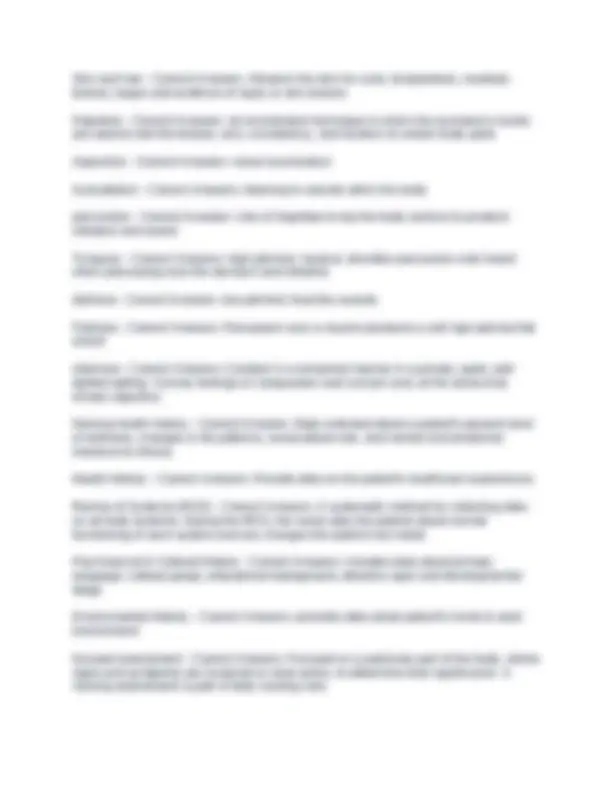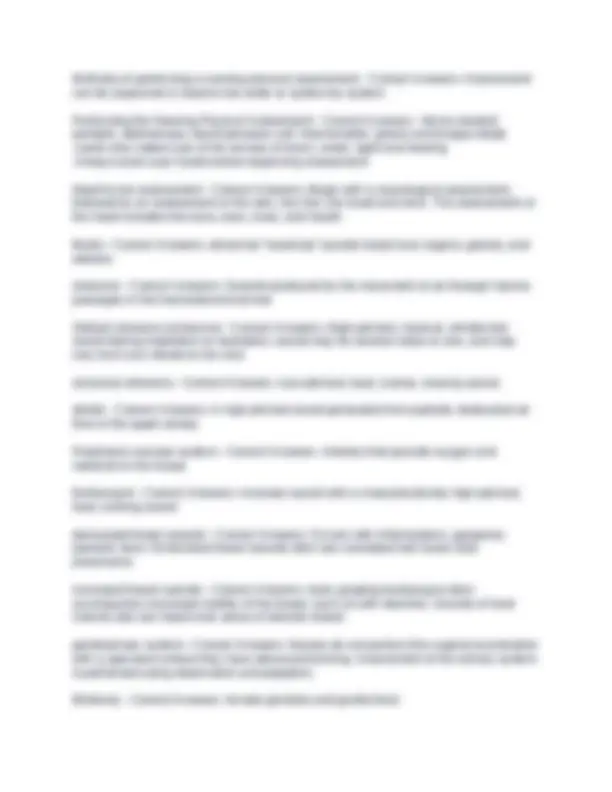





Study with the several resources on Docsity

Earn points by helping other students or get them with a premium plan


Prepare for your exams
Study with the several resources on Docsity

Earn points to download
Earn points by helping other students or get them with a premium plan
Community
Ask the community for help and clear up your study doubts
Discover the best universities in your country according to Docsity users
Free resources
Download our free guides on studying techniques, anxiety management strategies, and thesis advice from Docsity tutors
UNITEK CH. 13 PHYSICAL ASSESSMENT EXAM QUESTIONS AND ANSWERS
Typology: Exams
1 / 6

This page cannot be seen from the preview
Don't miss anything!




signs and symptoms - Correct Answers -Signs are objective data as perceived by the examiner. Examples: rashes; abnormal lung; heart sounds; visible drainage or exudate Drainage - Correct Answers -Passive or active removal of fluids from body cavity, wound, or other source of discharge by one or more methods Exudate - Correct Answers -Fluid, cells or other substances that are slowly exuded, or discharged, from cells or blood vessels through small pores or breaks in the cell membrane, usually a result of inflammation or injury Symptoms - Correct Answers -indications of disease reported by the patient. Examples: pain, nausea, vertigo, pruritus, diplopoa, numbness and anxiety subjective data - Correct Answers -Collection, interviewer encourages a full description by the patient of the onset and the character of the problem and any factors that aggravate or alleviate SBAR - Correct Answers -Situation, background, assessment, and recommendation Sitting position - Correct Answers -Position used during much of the physical examination including examination of the head, neck, lungs, chest, back, breast, axilla, heart, vital signs, and upper extremities supine position - Correct Answers -Head and neck, anterior thorax and lungs, breasts, axillae, heart, abdomen, extremities, pulses dorsal recumbent - Correct Answers -head and neck, anterior thorax and lungs, breasts, axillae, heart, abdomen Pruitis - Correct Answers -itching; example: Absence of response to pinprick confirms patient reports of numbness of a body part disease - Correct Answers -A pathogenic condition of the body, is a disturbance of a structure or function of the body
hereditary disease - Correct Answers -Disease is transmitted genetically from parents to children. Examples: Cystic fibrosis, sickle cell anemia, Color blindness and hemophilia congenital disease - Correct Answers -Diseases appear at birth or shortly there after but are not caused by genetic abnormalities. Example: Absence of limbs and blindness inflammatory diseases - Correct Answers -Diseases are those in which the body reacts with inflammatory response to some causative agent. degenerative diseases - Correct Answers -Degeneration, often progressive, have some part of the body. Infectious diseases - Correct Answers -Result from the Invasion of micro organisms into the body. Examples: Acquired immunodeficiency syndrome TB, measles, pneumonia deficiency disease - Correct Answers -Result from the lack of specific nutrient. Example iron deficiency anemia metabolic disease - Correct Answers -Caused by a dysfunction that results in a loss of metabolic control of homeostasis in the body. Example: hypothyroidism and acromegaly, involves Thyroid and pituitary glands neoplastic - Correct Answers -Abnormal growth of new tissue Environmental disease - Correct Answers -Group of conditions that develop from exposure to a harmful substance in the environment. Autoimmune responses - Correct Answers --body develops immunoglobuins (antibodies) against it's own tissues or body substances. Includes rheumatoid arthritis and ulcerative colitis risk factors - Correct Answers -Genetic and psychological, Age, environment, and lifestyle chronic disease - Correct Answers -Develops slowly and persosts over a long period of time often for a persons lifetime. remission - Correct Answers -Partial or complete disappearance of clinical and subjective characteristics of the disease that occurred, sometimes spontaneous and sometimes a result of therapy acute - Correct Answers -Begins abruptly with marked intensity of severe signs and symptoms and then often subsides over a period of treatment
Skin and hair - Correct Answers -Observe the skin for color, temperature, moisture texture, turgor and evidence of injury or skin lesions Palpation - Correct Answers -an examination technique in which the examiner's hands are used to feel the texture, size, consistency, and location of certain body parts inspection - Correct Answers -visual examination Auscultation - Correct Answers -listening to sounds within the body percussion - Correct Answers -Use of fingertips to top the body surface to produce vibration and sound Tympany - Correct Answers -high-pitched, musical, drumlike percussion note heard when percussing over the stomach and intestine dullness - Correct Answers -low-pitched, thud like sounds Flatness - Correct Answers -Percussion over a muscle produces a soft high-pitched flat sound interview - Correct Answers -Conduct in a unhurried manner in a private, quiet, well lighted setting. Convey feelings of compassion and concern and, at the same time remain objective. Nursing health history - Correct Answers -Data collected about a patient's present level of wellness, changes in life patterns, sociocultural role, and mental and emotional reactions to illness. Health History - Correct Answers -Provide data on the patient's healthcare experiences Review of Systems (ROS) - Correct Answers -A systematic method for collecting data on all body systems. During the ROS, the nurse asks the patient about normal functioning of each system and any changes the patient has noted. Psychosocial & Cultural History - Correct Answers -Includes data about primary language, cultural group, educational background, attention span and developmental stage Environmental History - Correct Answers -provides data about patient's home & work environment focused assessment - Correct Answers -Focused on a particular part of the body, where signs and symptoms are localized or most active, to determine their significance. A nursing assessment is part of daily nursing care.
Methods of performing a nursing physical assessment - Correct Answers -Assessment can be organized in head to toe order or system by system Performing the Nursing Physical Assessment - Correct Answers --Items needed: penlight, stethoscope, blood pressure cuff, thermometer, gloves and tongue blade -nurse also makes use of the senses of touch, smell, sight and hearing -Always wash your hands before beginning assessment Head to toe assessment - Correct Answers -Begin with a neurological assessment, followed by an assessment of the skin, the hair, the head and neck. The assessment of the head includes the eyes, ears, nose, and mouth. Bruits - Correct Answers -abnormal "swishing" sounds heard over organs, glands, and arteries wheezes - Correct Answers -Sounds produced by the movement of air through narrow passages in the tracheobronchial tree Sibilant wheezes (wheezes) - Correct Answers -High-pitched, musical, whistle-like sound during inspiration or expiration; sound may be several notes or one, and may vary from one minute to the next sonorous wheezes - Correct Answers -Low-pitched, loud, coarse, snoring sound. stridor - Correct Answers -A high pitched sound generated from partially obstructed air flow in the upper airway. Peripheral vascular system - Correct Answers -Arteries that provide oxygen and nutrients to the tissue Borborygmi - Correct Answers -Increase sound with a characteristically high-pitched, loud, rushing sound decreased bowel sounds - Correct Answers -Occurs with inflammation, gangrene, paralytic ileus. Diminished bowel sounds often are correlated with lower lobe pneumonia. Increased bowel sounds - Correct Answers -loud, gurgling borborygmi often accompanies increased motility of the bowel, such as with diarrhea. Sounds of loud volume also are heard over areas of stenotic bowel. genitourinary system - Correct Answers -Nurses do not perform the vaginal examination with a speculum unless they have advanced training. Assessment of the urinary system is performed using observation and palpation. lithotomy - Correct Answers -female genitalia and genital tract